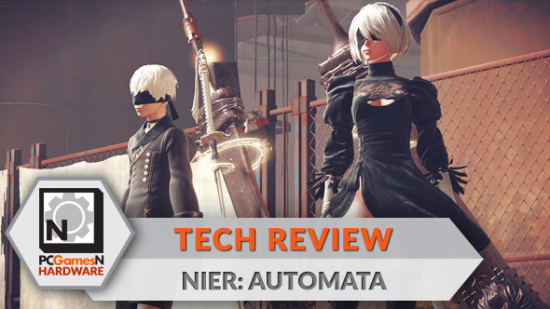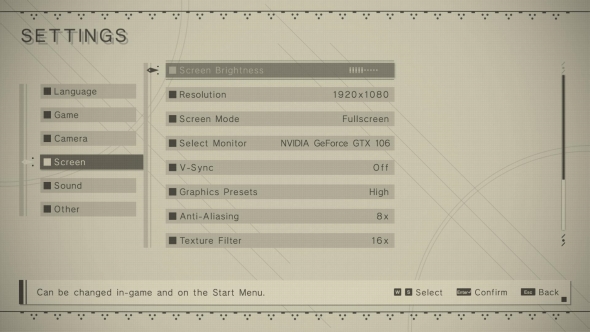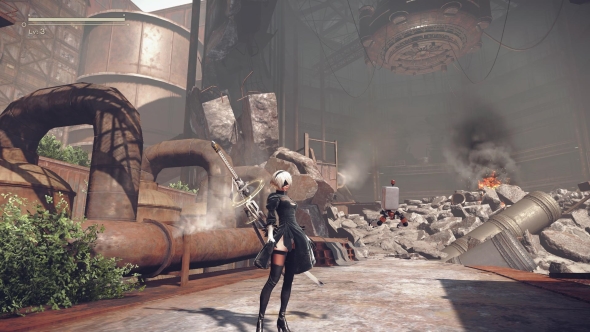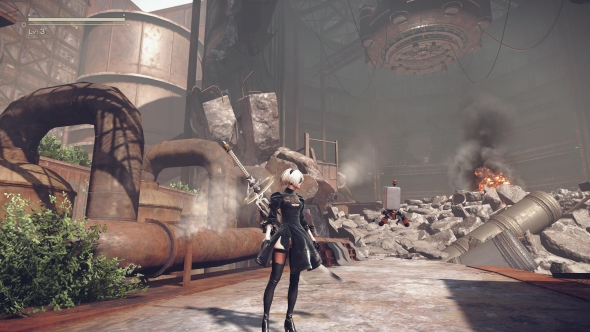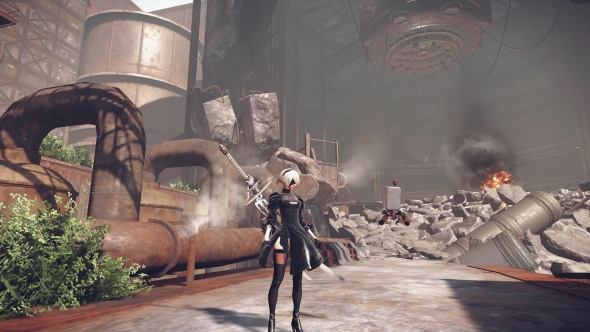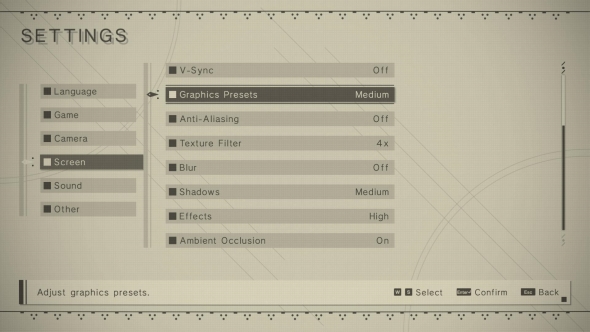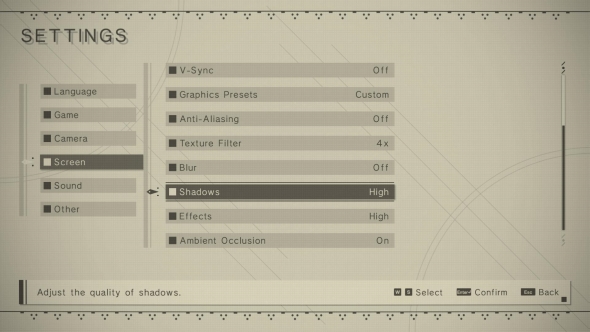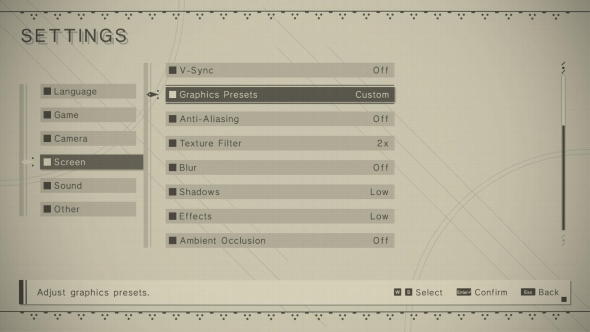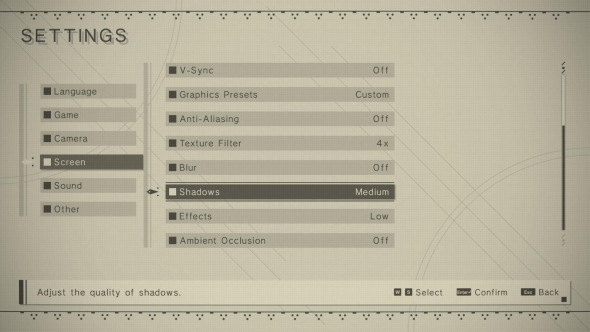Nier: Automata has been on the receiving end of a huge outpouring of love. Its been celebrated as a wonderful cultural oddity during its first weeks on console, and we awarded it 9/10 in our PC review. But while the design of the game, its story, aesthetic, and combat mechanics, may be top-tier, how is the technology behind it? And, most importantly, has it been ported to PC with care and attention? Japanese titles ported to PC have a spotty history, so we’re here to find out if everything’s stayed in the right place on the journey from PS4 land.
Explore strange new lands in the PC’s best RPGs.
Our tech reviews are written to offer you the broadest picture possible, focusing on hardware similar to what the majority of players have installed in their machines. We test the game on all graphical settings using an i5 powered rig with 8GB of RAM, and try to hit 60 fps with four of the most popular graphics cards. Even if your PC is not identical to our test set ups, you should still be able to estimate the performance levels you can expect from your own machine.
Graphics options
From the moment you boot Nier: Automata up, it’s clear that it is an incredibly bare bones port. The menus are on the clunky side, and are divided into odd sections. ‘Screen’ combines what we’d traditionally expect to be in video and graphics menus, and is made up of a slim 12 options, with just seven relating to graphical details. Shadows and effects are adjustable through a couple of settings, and blur and ambient occlusion can be turned on and off. Texture filtering can be adjusted from none up to 16x, and anti-aliasing can be set up to 8x. There are no options for changing the technology used to provide AA or AO, so you’re stuck with the mystery software that powers Nier.
Technically the game supports both controller and keyboard and mouse, but if you intend on playing Nier with the latter it’s probably worth uninstalling right now. Automata is a game designed for use with a controller, and only performs strongly with one. Thankfully the PC supports all kinds of peripherals so you can use pretty much any control pad you like, and you can remap a controller easily to suit your preferences. If you absolutely insist on using a K+M combo you can also remap controls, but for keyboard keys only. The game will default-bind light and heavy attacks to left and right mouse button, but on-screen tutorials will always prompt you to use a keyboard key (attack is bound to / by default, and you’re expected to pan the camera with the arrow keys). You can’t bind controls to mouse buttons, so forget about using your Razer Naga’s multitude of switches.
Graphics analysis
Tested on an Intel i5 6500k @3.2GHz, 8GB of RAM, Nvidia GTX 1060, Windows 10
For our graphics analysis we traditionally compare screenshots taken on the four standard presets of ultra, high, medium, and low. Unfortunately Nier only has three, so we’ll just be looking at high, medium, and low. On the plus side, you can swap between these in-game without restarting your session.
High
While Nier has its stylistic charms, it’s not a graphics technology powerhouse. As such, there’s nothing too fancy going on even at the highest preset. Model work is generally good, and there’s lots of nice detail in the machinery hanging from the ceiling. Shadows and lighting are fine, if slightly last-gen in feel. Overall it’s very similar to the quality that the PS4 is running.
At high settings Nier runs at an average of 50 fps on our GTX 1060-powered test rig. The game is capped at 60 fps, and it comes closer to that in more confined areas. But in the open areas that make up much of Nier’s world it settles around 50, and bottoms out at around 38 fps.
Medium
Dropping down to medium settings has practically zero impact on Nier’s visuals. Look closely and the only thing you’ll be able to see altered is the shadow work, which is now fuzzier and less precise. Everything else – lighting, textures, model work – remains very much intact.
Medium settings help you hit the frame rate cap… almost. 59 fps is the most I could squeeze out of the GTX 1060, although it was a very consistent frame rate with a low of 58 fps.
Low
Nier’s lowest setting has a far more notable impact. A complete lack of anti-aliasing means everything’s got a jagged edge; you can see it quite clearly on 2B’s character model. Every texture is lower resolution, which leads to the familiar ‘smeared’ effect that you’d expect of a low preset. The absence of ambient occlusion means shadow mapping is removed from detailed models like the ceiling-mounted machine at the top of the scene and among the leaves of the bush on the left-hand side.
Due to the frame rate cap, sacrificing graphical fidelity won’t boost performance. Low, like medium, runs at an average of 59 fps.
Performance benchmarks
To see how Nier: Automata performs on various hardware setups, we have tested the game on four graphics cards; two from Nvidia, and two from AMD. We’ve sampled the most popular cards from the current and last generation of GPUs in order to offer the most useful information.
All four cards were tested at high settings, with every option turned up as high as they’ll go. For the test we played a three-minute sample that involved exploration and combat.
In the graph below you can see how all four cards perform.
Despite not being the most detailed game, none of our four cards could hit 60 fps at high settings. This is pretty disappointing. Nier doesn’t appear to use any kind of special PC rendering techniques or bonus effects over the PS4 version, and its fairly static environments and mostly simple textures shouldn’t pose a challenge. But with the GTX 1060 only managing 50 fps on average, it’s very clear that Nier is following in the tradition of poor PC ports of Japanese titles. Only this year we saw Bandai Namco’s Tales of Symphonia receive flak for a lacklustre port, and few will have forgotten the mess that Dark Souls was in when it finally arrived on PC.
The GTX 970’s 41 fps makes Platinum’s super-smooth combat feel notably slower, with a similar feel on the RX 470. Both are playable though, should you be happy with a lower frame rate. The R9 380, alas, really does struggle. Despite only dropping 8 frames when the going gets rough, combat feels dreadful and sluggish.
How does Nier: Automata run in 4K?
Nier can run a bit on the iffy side at 1080p, but what if you own a 4K display? Our UHD test rig – rocking an i7 6700K CPU, an Nvidia GTX 1080, and displaying on an Acer Predator 4K monitor – doesn’t run smooth at all. At 3840 x 2160 resolution on ultra settings, Nier runs at an average of 15 fps, and a minimum of 12 fps. This makes Nier feel as if it’s running in slow-motion, and not in the cool anime combat way. Reducing it right down to low settings results in a far more playable 38 fps, but it’s still not displaying Nier at its best.
How to run Nier: Automata at 60 fps
If you’re running one of our test cards you’ll no doubt have one question: how do I run Nier at 60 fps? Platinum’s combat not only deserves to be played at 60 fps, but also requires it: without that speed it feels unwieldy and treacle-like.
Thanks to the game’s frame rate cap of 60 fps though, it’s actually impossible to maintain an average of 60 fps (dropped frames will always pull the average down, as there’s no high peaks to counteract them). As such, an average of 59 fps is as good as it gets in Nier.
For a breakdown of how to run Nier: Automata at as close to 60 fps as possible, see our settings guide below.
Nvidia GTX 970
The GTX 970 is a pretty solid card, and you should be able to hit an average of 59 fps with the medium preset. Considering it looks barely any different to the high preset, this isn’t a bad thing. Realistically you can afford to turn up anti-aliasing a touch and not feel a real impact on performance, but due to that frame rate limiter your average will be pulled down. It’s best to try out a few settings yourself and go with what feels best, rather than the numerical report.
Nvidia GTX 1060
Similar to the GTX 1060, using the medium preset will give you to the 59 fps average. You can also turn shadows up to high and maintain that average. Realistically you can play on high and the combat still feels fluid, but this comes at a price of a 50-ish fps average.
Traditionally I’d suggest a more precise method of achieving a better average, such as a tweak of dynamic reflections, or adjusting the method used for ambient occlusion. Unfortunately Nier’s lack of options means it’s more difficult to calibrate things in such a delicate manner. Many options are either on or off, or low or high. Thankfully such limited options does mean that Nier at medium still looks pretty good due to keeping many important settings turned on, and you’ll get the smooth performance needed.
AMD Radeon R9 380
AMD’s old R9 380 has a real rough time with Nier. You’re going to need to kick it down to low to get things running smoothly, but thankfully this will help you hit an average of 59 fps. You can afford to turn texture filtering up a notch without taking a real performance hit in more enclosed environments, but unfortunately everything else is too much of a power hog.
AMD Radeon RX 470
Despite being a newer card, the RX 470 also struggles with Nier. While not expecting it to hit the same performance levels as the GTX 1060, I was hoping it would run on more than almost minimum settings. Sadly you’ll need to opt for the low preset in order to squeeze 59 fps out of the 470. You can notch the shadows back up and increase texture filtering to 4x, but there’s no wiggle room on the anti-aliasing.
Conclusion
Nier: Automata is a PS4 game through and through, and that’s written all over its PC port. Thankfully it’s not a disaster: if you’ve bought Nier, you’ll almost certainly be able to install it and play without a great deal of hassle. Just plug in a controller and get to work on slashing up those red-eyed robots.
For anyone looking to do more with Nier, however, it’s bad news. Remapping for keyboards is barebones and doesn’t include mouse buttons. There’s an anaemic amount of graphical options, which essentially amount to ‘looks like the PS4 version’ or ‘looks worse than the PS4 version’. Wherever you use a mouse, be it on menus or to control 2B in-game, it feels floaty and detached.
The frame rate cap means you simply can’t get an average of 60 fps, and getting anywhere near that on older hardware – despite Nier’s simple graphical style – is difficult. The game feels unoptimised for PC, and as such you likely won’t get the performance you’d expect from your components.
There’s other odd niggles, too. Your windows cursor displays over the top of Nier, and so you’ll have to keep pushing it to the edge of the screen to get rid of it. If you were planning on capturing videos you’ll need to opt for windowed mode, as playing in fullscreen causes Nvidia Shadowplay to capture in a weird, stretched resolution. You’ll have a better results in fullscreen mode when using FRAPS, but it will heavily disrupt your performance.
Such video issues appear related to a resolution scaling issue that Nier suffers from in fullscreen mode. It’s an issue that’s being discussed online my many players, and the root of the problem appears to be in Windows downscaling and then re-upscaling the image. An unofficial mod has already been created to help fix it. The mod does disable Shadowplay and Nvidia Experience though, meaning you will still have to opt for windowed mode for video capture.
By all accounts Nier: Automata is a spectacular game. Our own 9/10 review emphasises its creative victories, and it’s a game that looks to feature on many GOTY lists. If the PC is your only option (and your rig isn’t a Morphy Richards 4-slice toaster) then don’t be afraid to buy. There’s nothing about this port that makes it unplayable. However, do be aware that the overall feeling is a bit like playing the game on a PS4 emulator; it’s just not quite at home. If you own a PlayStation 4 too, it’s probably obvious by now which your platform of choice should be.

